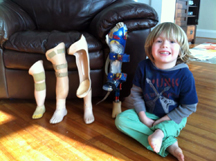Child to receive prosthetic leg designed by Purdue students
November 1, 2012
 |
|
A team of Purdue students has
designed a new type of prosthetic leg for 5-year-old Lucas Resch, who has a
rare birth defect that makes his left leg far shorter than his right. At left
are conventional prosthetics, which do not give Lucas the ability to run and
ride a bicycle or play like his friends. The new prosthetic leg, not shown,
uses an innovative gearbox design that enables the prosthetic to move more like
a real leg. (Photo provided by Resch family) |
WEST LAFAYETTE, Ind. – A team of Purdue University students has designed a new type of prosthetic leg for a 5-year-old boy who has a rare birth defect.
The leg uses an innovative gearbox design that enables the prosthesis to move like a real leg.
The boy, Lucas Resch, was born with only a fraction of his left femur, making his left leg far shorter than his right, a condition known as proximal femoral focal deficiency (PFFD).
Conventional prosthetics do not give Lucas the ability to run and ride a bicycle or play like his friends do, said his parents, Ned and Melissa Resch of Providence, RI.
He is active, and his parents have been searching for ways to allow him to retain that level of activity as he grows.
“He has a traditional prosthesis that basically just makes his legs the same length, but does very little for his mobility,” said Purdue doctoral student Anne Zakrajsek.
Zakrajsek developed an assistive technology senior design project as part of her work through the Bilsland Strategic Initiatives Fellowship.
The prosthesis was created by students Sajed Dosenbach, Alex Guerra, Ted Kramer, James Vandewalle, and Ben Zakhary. Dosenbach, Kramer and Vandewalle are mechanical engineering seniors, and the other students are biomedical engineering seniors.
Barring a new type of prosthetic leg, the family was told that the child's best hope was to undergo a surgical procedure in which the foot is rotated 180 degrees so that the ankle of the shorter leg could act as a knee joint. Then a traditional prosthesis could be used.
The Resches, however, sought a less radical solution, and learned about the "The Leg Up Project," a Purdue mechanical engineering senior design project in 2009 to create a prosthesis for an Indiana boy with PFFD. During an Internet search, Ned Resch came across a YouTube video about that project.
"He was running and riding a bike, just what we want Lucas to be able to do," he said.
Eventually, Ned Resch found a group of students in a senior design class who were willing to take on the project for Lucas.
The prosthesis uses a gearbox to produce a knee's range of motion. Whereas an ankle joint swivels about 40 degrees, a knee joint moves about 90 degrees. The new design hinges on the innovative gearbox that converts the ankle's limited movement to the motion of a knee, providing greater mobility.
Eric Nauman, a professor of mechanical engineering, was involved in the project, working with Darryl Dickerson, president of Adapt-IF Technologies, a nonprofit corporation that may make the technology available to others with PFFD.
“The engineering students have the technical and creative talent to develop innovative solutions to challenging problems,” said Dickerson, a Purdue alumnus who earned a doctoral degree in biomedical engineering in 2009. “We provided them with a basic problem statement and have allowed them the freedom to perform true design work from specification development to conceptual design and now prototype assembly and testing, which will occur when the Resch family visits.”
Lucas and his parents plan to be on campus Friday (Nov. 2) to meet with the students and begin fitting a new leg. He is scheduled to try out the prosthesis over the weekend, wearing it to the Purdue-Penn State football game.
The Purdue students will create a mold of Lucas's shin to make for a better fit, and the child's family will return later this year to receive the form-fitted leg. The leg will be adjusted as Lucas grows.
"We're so grateful," Ned Resch said. "As parents, it means so much to us that he may soon be running faster and riding a bike."
Adapt-IF Technologies may use the design approach to create similar prosthetics for other people who have birth defects affecting their legs.
“Beyond PFFD, there are other congenital disorders that cause a discrepancy in leg length, and this type of solution can be applicable to any such condition,” Dickerson said.
Ned Resch said Lucas is excited about getting a new leg, although he doesn't understand all of the details.
"In one of the videos we sent the team, he was bouncing around being goofy and saying things like 'thank you for my new leg' and 'I want a big super hero leg,'” Resch said.
Writers: Emil Venere, 765-494-4709, venere@purdue.edu
Judith Barra Austin, 765-494-2432, jbaustin@purdue.edu
Sources: Anne Zakrajsek, aedye@purdue.edu
Darryl Dickerson, darryl.dickerson@gmail.com
Ned Resch, nedresch1@gmail.com
Sajed Dosenbach, edosenba@purdue.edu
Alex Guerra, alexnguerra2000@yahoo.com
Ted Kramer, tjkramer@purdue.edu
James Vandewalle, javandew@purdue.edu
Ben Zakhary, bzakhary@purdue.edu
Note to Journalists: For local editors, here are home towns for the Purdue students: Sajed Dosenbach, Naperville, Ill.; Alex Guerra, Austin, Texas; Ted Kramer, Minneapolis; James Vandewalle, Columbus, Ohio; and Ben Zakhary, Carmel, Ind. Broadcast-quality B-Roll and sound bites are available. For more information contact Jim Schenke, Purdue News Service, 765-237-7296 or jschenke@purdue.edu

